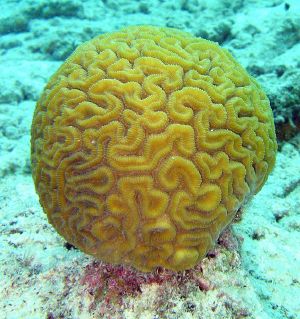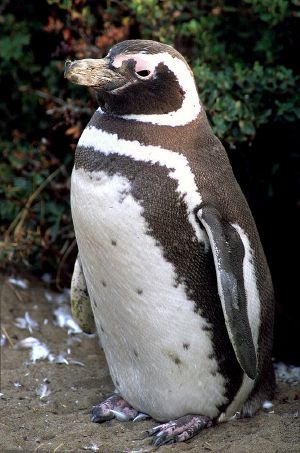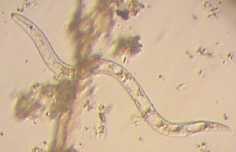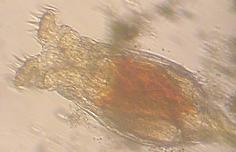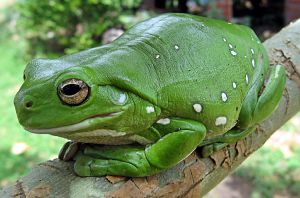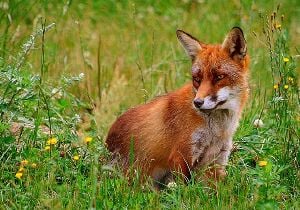Difference between revisions of "Animal" - New World Encyclopedia
Rick Swarts (talk | contribs) (Replaced with more recent Wikipedia article) |
Rick Swarts (talk | contribs) (updated version from Wikipedia) |
||
| Line 1: | Line 1: | ||
{{Contracted}}{{Status}} | {{Contracted}}{{Status}} | ||
| − | + | {{dablink|For other uses of the word "animal", see [[animal (disambiguation)]].}} | |
| − | {{ | + | {{Taxobox |
| − | + | | color = pink | |
| − | + | | name = Animals | |
| − | + | | image = Sea nettles.jpg | |
| − | + | | image_width = 250px | |
| − | + | | image_caption = [[Sea nettle]]s, ''Chrysaora quinquecirrha'' | |
| − | + | | domain = [[Eukaryote|Eukaryota]] | |
| + | | regnum = '''Animalia''' | ||
| + | | regnum_authority = [[Carolus Linnaeus|Linnaeus]], 1758 | ||
| + | | subdivision_ranks = Phyla | ||
| + | | subdivision = | ||
***[[Sponge|Porifera]] (sponges) | ***[[Sponge|Porifera]] (sponges) | ||
***[[Ctenophora]] (comb jellies) | ***[[Ctenophora]] (comb jellies) | ||
| Line 14: | Line 18: | ||
*'''''Subregnum [[Bilateria]]''''' ([[symmetry (biology)|bilateral symmetry]]) | *'''''Subregnum [[Bilateria]]''''' ([[symmetry (biology)|bilateral symmetry]]) | ||
***[[Acoelomorpha]] (basal) | ***[[Acoelomorpha]] (basal) | ||
| − | ***[[Orthonectida]] (flatworms, echinoderms, etc.) | + | ***[[Orthonectida]] (parasitic to flatworms, echinoderms, etc.) |
| − | **[[Rhombozoa]] (dicyemids) | + | ***[[Rhombozoa]] (dicyemids) |
| − | **[[Myxozoa]] (slime animals) | + | ***[[Myxozoa]] (slime animals) |
**'''Superphylum [[Deuterostome|Deuterostomia]]''' (blastopore becomes anus) | **'''Superphylum [[Deuterostome|Deuterostomia]]''' (blastopore becomes anus) | ||
***[[Chordate|Chordata]] (vertebrates, etc.) | ***[[Chordate|Chordata]] (vertebrates, etc.) | ||
***[[Hemichordata]] (acorn worms) | ***[[Hemichordata]] (acorn worms) | ||
***[[Echinoderm]]ata (starfish, urchins) | ***[[Echinoderm]]ata (starfish, urchins) | ||
| − | ***[[Chaetognatha]] (arrow | + | ***[[Chaetognatha]] ([[arrow worm]]s and [[Pterobranchia]]) |
**'''Superphylum [[Ecdysozoa]]''' (shed exoskeleton) | **'''Superphylum [[Ecdysozoa]]''' (shed exoskeleton) | ||
***[[Kinorhyncha]] (mud dragons) | ***[[Kinorhyncha]] (mud dragons) | ||
| Line 48: | Line 52: | ||
***[[Mollusca]] (mollusks) | ***[[Mollusca]] (mollusks) | ||
***[[Annelida]] (segmented worms) | ***[[Annelida]] (segmented worms) | ||
| − | + | }} | |
'''Animals''' are a major group of [[organism]]s, classified as the [[kingdom (biology)|kingdom]] '''Animalia''' or '''Metazoa'''. In general they are [[multicellular]], capable of locomotion and responsive to their environment, and feed by consuming other organisms. Their body plan becomes fixed as they develop, usually early on in their [[ontogeny|development]] as [[embryo]]s, although some undergo a process of [[metamorphosis (biology)|metamorphosis]] later on. | '''Animals''' are a major group of [[organism]]s, classified as the [[kingdom (biology)|kingdom]] '''Animalia''' or '''Metazoa'''. In general they are [[multicellular]], capable of locomotion and responsive to their environment, and feed by consuming other organisms. Their body plan becomes fixed as they develop, usually early on in their [[ontogeny|development]] as [[embryo]]s, although some undergo a process of [[metamorphosis (biology)|metamorphosis]] later on. | ||
| Line 55: | Line 59: | ||
==Characteristics== | ==Characteristics== | ||
| − | [[ | + | Kingdom Animalia has several characteristics that set it apart from other living things. Animals are [[eukaryote|eukaryotic]] and [[multicellular]], which separates them from [[bacteria]] and most [[protist]]s. They are [[heterotrophic]], generally digesting food in an internal chamber, which separates them from [[plant]]s and [[alga]]e. They are also distinguished from plants, algae, and [[fungus|fungi]] by lacking cell walls. |
| + | |||
| + | ==Structure== | ||
| + | With a few exceptions, most notably the [[sponge|sponges]] (Phylum Porifera), animals have bodies differentiated into separate [[biological tissue|tissues]]. These include [[muscle]]s, which are able to contract and control locomotion, and a [[nervous system]], which sends and processes signals. There is also typically an internal [[digestion|digestive]] chamber, with one or two openings. Animals with this sort of organization are called metazoans, or [[eumetazoan]]s when the former is used for animals in general. | ||
| − | + | All animals have [[eukaryotic]] cells, surrounded by a characteristic extracellular matrix composed of [[collagen]] and elastic [[glycoprotein]]s. This may be calcified to form structures like [[shell]]s, [[bone]]s, and [[spicule]]s. During development it forms a relatively flexible framework upon which cells can move about and be reorganized, making complex structures possible. In contrast, other multicellular organisms like plants and fungi have cells held in place by cell walls, and so develop by progressive growth. Also, unique to animal cells are the following intercellular junctions: [[tight junction]]s, [[gap junction]]s, and [[desmosome]]s. | |
== Reproduction and development == | == Reproduction and development == | ||
| Line 76: | Line 83: | ||
== Groups of animals == | == Groups of animals == | ||
| + | [[Image:Elephant-ear-sponge.jpg|thumb|left|Elephant ear [[sponge]]]] | ||
| + | The sponges ([[Porifera]]) diverged from other animals early. As mentioned, they lack the complex organization found in most other phyla. Their cells are differentiated, but not organized into distinct tissues. Sponges are sessile and typically feed by drawing in water through [[pore]]s all Archaeocyatha]], which have fused skeletons, may represent sponges or a separate phylum. | ||
| − | + | [[Image:Brain_coral.jpg|thumb|right|[[Brain Coral]]]] | |
| − | + | Among the eumetazoan phyla, two are radially symmetric and have digestive chambers with a single opening, which serves as both the mouth and the anus. These are the [[Cnidaria]], which include [[sea anemone]]s, [[coral]]s, and [[jellyfish]], and the [[Ctenophora]] or comb jellies. Both have distinct tissues, but they are not organized into [[organ (anatomy)|organs]]. There are only two main germ layers, the ectoderm and endoderm, with only scattered cells between them. As such, these animals are sometimes called [[diploblastic]]. The tiny phylum [[Placozoa]] is similar, but individuals do not have a permanent digestive chamber. | |
| − | Among the eumetazoan phyla, two are radially symmetric and have digestive chambers with a single opening, which serves as both the mouth and the anus. These are the [[Cnidaria]], which include [[anemone]]s, [[coral]]s, and [[jellyfish]], and the [[Ctenophora]] or comb jellies. Both have distinct tissues, but they are not organized into [[organ (anatomy)|organs]]. There are only two main germ layers, the ectoderm and endoderm, with only scattered cells between them. As such, these animals are sometimes called [[diploblastic]]. The tiny phylum [[Placozoa]] is similar, but individuals do not have a permanent digestive chamber. | ||
The remaining animals form a monophyletic group called the [[Bilateria]]. For the most part, they are bilaterally symmetric, and often have a specialized head with feeding and sensory organs. The body is [[triploblastic]], i.e. all three germ layers are well-developed, and tissues form distinct organs. The digestive chamber has two openings, a mouth and an anus, and there is also an internal body cavity called a coelom or pseudocoelom. There are exceptions to each of these characteristics, however - for instance adult [[echinoderm]]s are radially symmetric, and certain parasitic worms have extremely simplified body structures. | The remaining animals form a monophyletic group called the [[Bilateria]]. For the most part, they are bilaterally symmetric, and often have a specialized head with feeding and sensory organs. The body is [[triploblastic]], i.e. all three germ layers are well-developed, and tissues form distinct organs. The digestive chamber has two openings, a mouth and an anus, and there is also an internal body cavity called a coelom or pseudocoelom. There are exceptions to each of these characteristics, however - for instance adult [[echinoderm]]s are radially symmetric, and certain parasitic worms have extremely simplified body structures. | ||
| + | [[Image:Common_clownfish.jpg|thumb|right|[[Clownfish]] in their [[Sea Anemone]] home]] | ||
Genetic studies have considerably changed our understanding of the relationships within the Bilateria. Most appear to belong to four major lineages: | Genetic studies have considerably changed our understanding of the relationships within the Bilateria. Most appear to belong to four major lineages: | ||
# [[Deuterostomes]] | # [[Deuterostomes]] | ||
| Line 91: | Line 100: | ||
In addition to these, there are a few small groups of bilaterians with relatively similar structure that appear to have diverged before these major groups. These include the [[Acoelomorpha]], [[Rhombozoa]], and [[Orthonectida]]. The [[Myxozoa]], single-celled parasites that were originally considered Protozoa, are now believed to have developed from the Bilateria as well. | In addition to these, there are a few small groups of bilaterians with relatively similar structure that appear to have diverged before these major groups. These include the [[Acoelomorpha]], [[Rhombozoa]], and [[Orthonectida]]. The [[Myxozoa]], single-celled parasites that were originally considered Protozoa, are now believed to have developed from the Bilateria as well. | ||
| + | [[Image:Magellanic-penguin02.jpg|thumb|left|the [[Magellanic Penguin]]]] | ||
=== Deuterostomes === | === Deuterostomes === | ||
| − | |||
[[Deuterostome]]s differ from the other Bilateria, called [[protostome]]s, in several ways. In both cases there is a complete digestive tract. However, in protostomes the initial opening (the [[archenteron]]) develops into the mouth, and an anus forms separately. In deuterostomes this is reversed. In most protostomes cells simply fill in the interior of the gastrula to form the mesoderm, called schizocoelous development, but in deuterostomes it forms through [[invagination]] of the endoderm, called enterocoelic pouching. Deuterostomes also have a dorsal, rather than a ventral, nerve chord and their embryos undergo different cleavage. | [[Deuterostome]]s differ from the other Bilateria, called [[protostome]]s, in several ways. In both cases there is a complete digestive tract. However, in protostomes the initial opening (the [[archenteron]]) develops into the mouth, and an anus forms separately. In deuterostomes this is reversed. In most protostomes cells simply fill in the interior of the gastrula to form the mesoderm, called schizocoelous development, but in deuterostomes it forms through [[invagination]] of the endoderm, called enterocoelic pouching. Deuterostomes also have a dorsal, rather than a ventral, nerve chord and their embryos undergo different cleavage. | ||
| Line 100: | Line 109: | ||
=== Ecdysozoa === | === Ecdysozoa === | ||
| − | + | [[Image:Sympetrum flaveolum - side (aka).jpg|thumb|the [[Yellow-winged Darter]]]] | |
The [[Ecdysozoa]] are protostomes, named after the common trait of growth by moulting or [[ecdysis]]. The largest animal phylum belongs here, the [[Arthropoda]], including [[insect]]s, [[spider]]s, [[crab]]s, and their kin. All these organisms have a body divided into repeating segments, typically with paired appendages. Two smaller phyla, the [[Onychophora]] and [[Tardigrada]], are close relatives of the arthropods and share these traits. | The [[Ecdysozoa]] are protostomes, named after the common trait of growth by moulting or [[ecdysis]]. The largest animal phylum belongs here, the [[Arthropoda]], including [[insect]]s, [[spider]]s, [[crab]]s, and their kin. All these organisms have a body divided into repeating segments, typically with paired appendages. Two smaller phyla, the [[Onychophora]] and [[Tardigrada]], are close relatives of the arthropods and share these traits. | ||
| + | [[Image:roundworm.jpg|thumb|left|[[Roundworm]]]] | ||
The ecdysozoans also include the [[Nematoda]] or roundworms, the second largest animal phylum. Roundworms are typically microscopic, and occur in nearly every environment where there is water. A number are important parasites. Smaller phyla related to them are the [[Nematomorpha]] or horsehair worms, which are visible to the unaided eye, and the [[Kinorhyncha]], [[Priapulida]], and [[Loricifera]], which are all microscopic. These groups have a reduced coelom, called a pseudocoelom. | The ecdysozoans also include the [[Nematoda]] or roundworms, the second largest animal phylum. Roundworms are typically microscopic, and occur in nearly every environment where there is water. A number are important parasites. Smaller phyla related to them are the [[Nematomorpha]] or horsehair worms, which are visible to the unaided eye, and the [[Kinorhyncha]], [[Priapulida]], and [[Loricifera]], which are all microscopic. These groups have a reduced coelom, called a pseudocoelom. | ||
The remaining two groups of protostomes are sometimes grouped together as the Spiralia, since in both embryos develop with spiral cleavage. | The remaining two groups of protostomes are sometimes grouped together as the Spiralia, since in both embryos develop with spiral cleavage. | ||
| + | [[Image:Bedford-s_flatworm.jpg|thumb|left|Bedford's [[Flatworm]]]] | ||
=== Platyzoa === | === Platyzoa === | ||
| + | The [[Platyzoa]] include the phylum [[Platyhelminthes]], the flatworms. These were originally considered some of the most primitive Bilateria, but it now appears they developed from more complex ancestors. | ||
| − | + | [[Image:Rotifer.jpg|thumb|right|[[Rotifer]]]] | |
| + | A number of parasites are included in this group, such as the [[fluke]]s and [[tapeworm]]s. Flatworms lack a coelom, as do their closest relatives, the microscopic [[Gastrotricha]]. | ||
The other platyzoan phyla are microscopic and pseudocoelomate. The most prominent are the [[Rotifera]] or rotifers, which are common in aqueous environments. They also include the [[Acanthocephala]] or spiny-headed worms, the [[Gnathostomulida]], [[Micrognathozoa]], and possibly the [[Cycliophora]]. These groups share the presence of complex jaws, from which they are called the [[Gnathifera]]. | The other platyzoan phyla are microscopic and pseudocoelomate. The most prominent are the [[Rotifera]] or rotifers, which are common in aqueous environments. They also include the [[Acanthocephala]] or spiny-headed worms, the [[Gnathostomulida]], [[Micrognathozoa]], and possibly the [[Cycliophora]]. These groups share the presence of complex jaws, from which they are called the [[Gnathifera]]. | ||
=== Lophotrochozoa === | === Lophotrochozoa === | ||
| − | + | [[Image:Reef2063.jpg|thumb|Big Blue [[Octopus]]]] | |
The [[Lophotrochozoa]] include two of the most successful animal phyla, the [[Mollusca]] and [[Annelida]]. The former includes animals such as [[snail]]s, [[clam]]s, and [[squid]]s, and the latter comprises the segmented worms, such as [[earthworm]]s and [[leech]]es. These two groups have long been considered close relatives because of the common presence of [[trochophore]] larvae, but the annelids were considered closer to the arthropods, because they are both segmented. Now this is generally considered convergent evolution, owing to many morphological and genetic differences between the two phyla. | The [[Lophotrochozoa]] include two of the most successful animal phyla, the [[Mollusca]] and [[Annelida]]. The former includes animals such as [[snail]]s, [[clam]]s, and [[squid]]s, and the latter comprises the segmented worms, such as [[earthworm]]s and [[leech]]es. These two groups have long been considered close relatives because of the common presence of [[trochophore]] larvae, but the annelids were considered closer to the arthropods, because they are both segmented. Now this is generally considered convergent evolution, owing to many morphological and genetic differences between the two phyla. | ||
| Line 120: | Line 133: | ||
== History of classification == | == History of classification == | ||
| + | [[Image:Caerulea3 crop.jpg|thumb|left|[[White's Tree Frog]]]] | ||
| + | [[Image:Rød ræv (Vulpes vulpes).jpg|thumb|''Vulpes vulpes'', the [[red fox]]]] | ||
| + | [[Aristotle]] divided the living world between animals and [[plant]]s, and this was followed by [[Carolus Linnaeus]] in the first hierarchical classification. Since then biologists have begun emphasizing evolutionary relationships, and so these groups have been restricted somewhat. For instance, microscopic [[protozoa]] were originally considered animals because they move, but are now treated separately. | ||
| + | |||
In [[Carolus Linnaeus|Linnaeus]]' original scheme, the animals were one of three kingdoms, divided into the classes of [[Vermes]], [[Insect]]a, [[Fish|Pisces]], [[Amphibia]], [[bird|Aves]], and [[Mammal]]ia. Since then the last four have all been subsumed into a single phylum, the [[chordate|Chordata]], whereas the various other forms have been separated out. The above lists represent our current understanding of the group, though there is some variation from source to source. | In [[Carolus Linnaeus|Linnaeus]]' original scheme, the animals were one of three kingdoms, divided into the classes of [[Vermes]], [[Insect]]a, [[Fish|Pisces]], [[Amphibia]], [[bird|Aves]], and [[Mammal]]ia. Since then the last four have all been subsumed into a single phylum, the [[chordate|Chordata]], whereas the various other forms have been separated out. The above lists represent our current understanding of the group, though there is some variation from source to source. | ||
| Line 129: | Line 146: | ||
{{col-begin}} | {{col-begin}} | ||
{{col-5}} | {{col-5}} | ||
| + | |||
| + | *[[aardvark]] | ||
| + | *[[afghan hound]] | ||
| + | *[[albatross]] | ||
*[[alligator]] | *[[alligator]] | ||
*[[alpaca]] | *[[alpaca]] | ||
| − | *[[ant]] | + | *[[anaconda]] |
| + | *[[angel fish]] | ||
| + | *[[ant]] | ||
| + | *[[antlion]] | ||
| + | *[[anteater]] | ||
*[[antelope]] | *[[antelope]] | ||
| + | *[[ape]] | ||
| + | *[[aphid]] | ||
| + | *[[armadillo]] | ||
| + | *[[asp]] | ||
| + | *[[bacteria]] | ||
| + | *[[baboon]] | ||
*[[badger (animal)|badger]] | *[[badger (animal)|badger]] | ||
| + | *[[bald eagle]] | ||
| + | *[[bandicoot]] | ||
| + | *[[barnacle]] | ||
| + | *[[common Basilisk|basilisk]] | ||
| + | *[[barracuda]] | ||
| + | *[[bass (fish)|bass]] | ||
| + | *[[basset hound]] | ||
*[[bat]] | *[[bat]] | ||
| − | *[[bear]] | + | *[[bear]] |
| + | *[[beaver]] | ||
| + | *[[bed bug]] | ||
*[[bee]] | *[[bee]] | ||
*[[beetle]] | *[[beetle]] | ||
*[[bird]] | *[[bird]] | ||
| − | *[[bison]] | + | *[[bison]] |
| + | *[[blackbird]] | ||
| + | *[[black panther]] | ||
| + | *[[black widow]] | ||
| + | *[[blue jay]] | ||
| + | *[[blue whale]] | ||
| + | *[[boa]] | ||
| + | *[[bobcat]] | ||
| + | *[[booby]] | ||
| + | *[[Boston Terrier|boston terrier]] | ||
| + | *[[bison|buffalo]] | ||
| + | *[[bug]] | ||
| + | *[[bulldog]] | ||
| + | *[[Bull Terrier|bull terrier]] | ||
*[[butterfly]] | *[[butterfly]] | ||
| + | *[[buzzard]] | ||
| + | *[[camel]] | ||
| + | *[[canid]] | ||
| + | *[[cape buffalo]] | ||
| + | *[[cardinal (bird)]] | ||
| + | *[[caribou]] | ||
| + | *[[carp]] | ||
*[[cat]] | *[[cat]] | ||
| + | *[[caterpillar]] | ||
| + | *[[catfish]] | ||
| + | *[[centipede]] | ||
| + | *[[cephalopod]] | ||
| + | *[[chameleon]] | ||
| + | *[[cheetah]] | ||
| + | *[[chickadee]] | ||
*[[chicken]] | *[[chicken]] | ||
| + | *[[chihuahua]] | ||
*[[chimpanzee]] | *[[chimpanzee]] | ||
| − | + | *[[chinchilla]] | |
| + | *[[chipmunk]] | ||
| + | *[[clam]] | ||
| + | *[[cobra]] | ||
*[[cockroach]] | *[[cockroach]] | ||
| + | *[[cod]] | ||
| + | *[[collie]] | ||
| + | *[[condor]] | ||
| + | *[[constrictor]] | ||
*[[coral]] | *[[coral]] | ||
| + | *[[cougar]] | ||
| + | *[[coyote]] | ||
*[[cattle|cow]] | *[[cattle|cow]] | ||
| + | *[[crab]] | ||
| + | {{col-5}} | ||
| + | *[[crane (bird)|crane]] | ||
| + | *[[crane fly]] | ||
| + | *[[crawdad]] | ||
| + | *[[crayfish]] | ||
| + | *[[cricket (insect)|cricket]] | ||
*[[crocodile]] | *[[crocodile]] | ||
| + | *[[crow]] | ||
| + | *[[cuckoo]] | ||
| + | *[[daddy longlegs]] | ||
| + | *[[damselfly]] | ||
*[[deer]] | *[[deer]] | ||
| + | *[[dingo]] | ||
*[[dinosaur]] | *[[dinosaur]] | ||
*[[dog]] | *[[dog]] | ||
*[[dolphin]] | *[[dolphin]] | ||
| + | *[[donkey]] | ||
| + | *[[dormouse]] | ||
| + | *[[dove]] | ||
| + | *[[dragonfly]] | ||
| + | *[[duck]] | ||
| + | *[[dung beetle]] | ||
| + | *[[eagle]] | ||
*[[earthworm]] | *[[earthworm]] | ||
| + | *[[earwig]] | ||
| + | *[[eel]] | ||
| + | *[[egret]] | ||
*[[elephant]] | *[[elephant]] | ||
*[[elk]] | *[[elk]] | ||
| + | *[[emu]] | ||
| + | *[[English Pointer|english pointer]] | ||
| + | *[[English Setter|english setter]] | ||
| + | *[[ermine]] | ||
| + | *[[falcon]] | ||
| + | *[[ferret]] | ||
| + | *[[finch]] | ||
| + | *[[firefly]] | ||
*[[fish]] | *[[fish]] | ||
| − | *[[fly]] | + | *[[flamingo]] |
| + | *[[flea]] | ||
| + | *[[fly]] | ||
| + | *[[flyingfish]] | ||
| + | *[[fowl]] | ||
*[[fox]] | *[[fox]] | ||
| − | *[[frog]] | + | *[[frog]] |
| − | + | *[[fruit bat]] | |
| + | *[[gazelle]] | ||
| + | *[[gecko]] | ||
| + | *[[gerbil]] | ||
| + | *[[German Shepherd Dog|german shepherd]] | ||
| + | *[[giant panda]] | ||
| + | *[[giant squid]] | ||
| + | *[[gibbon]] | ||
| + | *[[gila monster]] | ||
| + | *[[guineafowl]] | ||
*[[giraffe]] | *[[giraffe]] | ||
| − | *[[goat]] | + | *[[goat]] |
| + | *[[golden retriever]] | ||
| + | *[[goldfinch]] | ||
| + | *[[goldfish]] | ||
| + | *[[goose]] | ||
| + | *[[gopher]] | ||
*[[gorilla]] | *[[gorilla]] | ||
| − | *[[hippopotamus]] | + | *[[grasshopper]] |
| − | *[[horse]] | + | *[[great blue heron]] |
| − | *[[ | + | *[[great dane]] |
| − | *[[iguana]] | + | *[[great white shark]] |
| + | *[[greyhound]] | ||
| + | *[[grizzly bear]] | ||
| + | *[[grouse]] | ||
| + | *[[guinea pig]] | ||
| + | *[[gull]] | ||
| + | *[[guppy]] | ||
| + | *[[haddock]] | ||
| + | *[[halibut]] | ||
| + | *[[hammerhead shark]] | ||
| + | *[[hamster]] | ||
| + | *[[hare]] | ||
| + | *[[harrier (bird)|harrier]] | ||
| + | *[[hawk]] | ||
| + | *[[hedgehog]] | ||
| + | {{col-5}} | ||
| + | *[[hermit crab]] | ||
| + | *[[heron]] | ||
| + | *[[herring]] | ||
| + | *[[hippopotamus]] | ||
| + | *[[hookworm]] | ||
| + | *[[hornet]] | ||
| + | *[[horse]] | ||
| + | *[[hound]] | ||
| + | *[[hummingbird]] | ||
| + | *[[humpback whale]] | ||
| + | *[[husky]] | ||
| + | *[[hyena]] | ||
| + | *[[iguana]] | ||
| + | *[[impala]] | ||
| + | *[[insect]] | ||
| + | *[[Irish Setter|irish setter]] | ||
| + | *[[Irish Wolfhound|irish wolfhound]] | ||
| + | *[[jackal]] | ||
| + | *[[jaguar]] | ||
| + | *[[jay]] | ||
*[[jellyfish]] | *[[jellyfish]] | ||
*[[kangaroo]] | *[[kangaroo]] | ||
| + | *[[kangaroo mouse]] | ||
| + | *[[kangaroo rat]] | ||
| + | *[[kingfisher]] | ||
| + | *[[kite (bird)|kite]] | ||
| + | *[[kiwi]] | ||
| + | *[[koala]] | ||
| + | *[[koi]] | ||
| + | *[[komodo dragon]] | ||
| + | *[[krill]] | ||
| + | *[[labrador retriever]] | ||
| + | *[[ladybug]] | ||
| + | *[[lamprey]] | ||
| + | *[[lark]] | ||
| + | *[[leech]] | ||
| + | *[[lemming]] | ||
| + | *[[lemur]] | ||
| + | *[[leopard]] | ||
| + | *[[leopon]] | ||
| + | *[[liger]] | ||
*[[lion]] | *[[lion]] | ||
*[[lizard]] | *[[lizard]] | ||
| − | *[[llama]] | + | *[[llama]] |
| − | *[[lynx]] | + | *[[lobster]] |
| + | *[[locust]] | ||
| + | *[[loon]] | ||
| + | *[[louse]] | ||
| + | *[[lungfish]] | ||
| + | *[[lynx]] | ||
| + | *[[macaw]] | ||
| + | *[[mackerel]] | ||
| + | *[[magpie]] | ||
| + | *[[mammal]] | ||
| + | *[[manta ray]] | ||
| + | *[[marlin]] | ||
| + | *[[marmoset]] | ||
| + | *[[marmot]] | ||
| + | *[[marsupial]] | ||
| + | *[[marten]] | ||
| + | *[[mastiff]] | ||
| + | *[[meadowlark]] | ||
| + | *[[mink]] | ||
| + | *[[minnow]] | ||
| + | *[[mite]] | ||
| + | *[[mockingbird]] | ||
| + | *[[mole]] | ||
| + | *[[mollusk]] | ||
| + | *[[mongoose]] | ||
| + | *[[monitor lizard]] | ||
*[[monkey]] | *[[monkey]] | ||
| + | *[[moose]] | ||
| + | *[[mosquito]] | ||
| + | *[[moth]] | ||
| + | *[[mountain goat]] | ||
*[[mouse]] | *[[mouse]] | ||
| + | *[[mule]] | ||
| + | *[[muskox]] | ||
| + | *[[mussel]] | ||
{{col-5}} | {{col-5}} | ||
| + | *[[narwhal]] | ||
| + | *[[newt]] | ||
*[[nightingale]] | *[[nightingale]] | ||
| − | *[[octopus]] | + | *[[ocelot]] |
| + | *[[octopus]] | ||
| + | *[[Old English Sheepdog|old english sheepdog]] | ||
| + | *[[opossum]] | ||
| + | *[[orangutan]] | ||
| + | *[[orca]] | ||
| + | *[[ostrich]] | ||
| + | *[[otter]] | ||
*[[owl]] | *[[owl]] | ||
| − | *[[ox]] | + | *[[ox]] |
| + | *[[oyster]] | ||
| + | *[[panda]] | ||
| + | *[[panther]] | ||
| + | *[[panthera hybrid]] | ||
| + | *[[parakeet]] | ||
*[[parrot]] | *[[parrot]] | ||
| − | *[[penguin]] | + | *[[parrotfish]] |
| − | *[[pig]] | + | *[[peacock]] |
| + | *[[pekingese]] | ||
| + | *[[pelican]] | ||
| + | *[[penguin]] | ||
| + | *[[perch]] | ||
| + | *[[Peregrine Falcon|peregrine falcon]] | ||
| + | *[[persian (cat)|persian cat]] | ||
| + | *[[pheasant]] | ||
| + | *[[pig]] | ||
| + | *[[pigeon]] | ||
| + | *[[pike (fish)|pike]] | ||
| + | *[[pilot whale]] | ||
| + | *[[piranha]] | ||
| + | *[[platypus]] | ||
| + | *[[polar bear]] | ||
| + | *[[poodle]] | ||
| + | *[[porcupine]] | ||
| + | *[[porpoise]] | ||
| + | *[[portuguese man o' war]] | ||
| + | *[[possum]] | ||
| + | *[[prairie dog]] | ||
| + | *[[prawn]] | ||
| + | *[[praying mantis]] | ||
| + | *[[primate]] | ||
| + | *[[puffin]] | ||
| + | *[[puma]] | ||
| + | *[[python]] | ||
*[[quail]] | *[[quail]] | ||
*[[rabbit]] | *[[rabbit]] | ||
| + | *[[raccoon]] | ||
| + | *[[rainbow trout]] | ||
*[[rat]] | *[[rat]] | ||
| + | *[[rattlesnake]] | ||
| + | *[[raven]] | ||
| + | *[[reindeer]] | ||
*[[rhinoceros]] | *[[rhinoceros]] | ||
| + | *[[right whale]] | ||
| + | *[[roadrunner]] | ||
| + | *[[robin]] | ||
| + | *[[rodent]] | ||
| + | *[[roundworm]] | ||
| + | *[[sailfish]] | ||
| + | *[[St. Bernard (dog)|saint bernard]] | ||
*[[salamander]] | *[[salamander]] | ||
| + | *[[salmon]] | ||
| + | *[[sawfish]] | ||
| + | *[[scallop]] | ||
*[[scorpion]] | *[[scorpion]] | ||
*[[hippocampus (fish)|seahorse]] | *[[hippocampus (fish)|seahorse]] | ||
| + | *[[sea lion]] | ||
| + | *[[sea slug]] | ||
| + | *[[sea urchin]] | ||
| + | *[[setter]] | ||
*[[shark]] | *[[shark]] | ||
| + | *[[sheep]] | ||
| + | *[[sheepdog]] | ||
| + | *[[shrew]] | ||
| + | *[[shrimp]] | ||
| + | *[[siamese (cat)|siamese cat]] | ||
| + | *[[silkworm]] | ||
{{col-5}} | {{col-5}} | ||
| − | *[[ | + | *[[silverfish]] |
| + | *[[skink]] | ||
| + | *[[skunk]] | ||
*[[sloth]] | *[[sloth]] | ||
| + | *[[slug]] | ||
| + | *[[smelt]] | ||
| + | *[[snail]] | ||
*[[snake]] | *[[snake]] | ||
| + | *[[snipe]] | ||
| + | *[[snow leopard]] | ||
| + | *[[sockeye salmon]] | ||
| + | *[[sole]] | ||
| + | *[[spaniel]] | ||
| + | *[[sperm whale]] | ||
*[[spider]] | *[[spider]] | ||
| + | *[[spider monkey]] | ||
| + | *[[spoonbill]] | ||
*[[squid]] | *[[squid]] | ||
| + | *[[squirrel]] | ||
*[[starfish]] | *[[starfish]] | ||
| + | *[[Star-nosed Mole|star-nosed mole]] | ||
| + | *[[steelhead trout]] | ||
| + | *[[stoat]] | ||
| + | *[[stork]] | ||
| + | *[[sturgeon]] | ||
| + | *[[swallow]] | ||
| + | *[[swan]] | ||
| + | *[[swift]] | ||
| + | *[[swordfish]] | ||
| + | *[[swordtail]] | ||
| + | *[[tabby cat]] | ||
| + | *[[tahr]] | ||
| + | *[[takin]] | ||
| + | *[[tapeworm]] | ||
| + | *[[tapir]] | ||
| + | *[[tarantula]] | ||
| + | *[[tasmanian devil]] | ||
| + | *[[termite]] | ||
| + | *[[tern]] | ||
| + | *[[terrier]] | ||
| + | *[[thrush]] | ||
*[[tiger]] | *[[tiger]] | ||
| + | *[[tiger shark]] | ||
| + | *[[tigon]] | ||
| + | *[[toad]] | ||
| + | *[[tortoise]] | ||
| + | *[[toucan]] | ||
| + | *[[Toy Poodle|toy poodle]] | ||
| + | *[[trapdoor spider]] | ||
| + | *[[tree frog]] | ||
| + | *[[trout]] | ||
| + | *[[tuna]] | ||
| + | *[[turkey]] | ||
*[[turtle]] | *[[turtle]] | ||
| + | *[[tyrannosaurus]] | ||
*[[urial]] | *[[urial]] | ||
| + | *[[vampire bat]] | ||
| + | *[[viper]] | ||
| + | *[[virus]] | ||
*[[vole]] | *[[vole]] | ||
| + | *[[vulture]] | ||
| + | *[[wallaby]] | ||
| + | *[[walrus]] | ||
| + | *[[wasp]] | ||
| + | *[[warbler]] | ||
| + | *[[water buffalo]] | ||
| + | *[[weasel]] | ||
*[[whale]] | *[[whale]] | ||
| + | *[[whitefish]] | ||
| + | *[[whooping crane]] | ||
| + | *[[wild cat]] | ||
| + | *[[wildebeest]] | ||
*[[wolf]] | *[[wolf]] | ||
| + | *[[wolverine]] | ||
| + | *[[wombat]] | ||
| + | *[[woodpecker]] | ||
*[[worm]] | *[[worm]] | ||
| + | *[[wren]] | ||
*[[yak]] | *[[yak]] | ||
*[[zebra]] | *[[zebra]] | ||
{{col-end}} | {{col-end}} | ||
| − | |||
| − | |||
| − | |||
| − | |||
| − | |||
| − | |||
| − | |||
| − | |||
| − | |||
| − | |||
| − | |||
| − | |||
| − | |||
| − | |||
| − | |||
| − | |||
| − | |||
| − | |||
| − | |||
| − | |||
| − | |||
| − | |||
==Reference== | ==Reference== | ||
| Line 239: | Line 558: | ||
{{Sisterlinks|Animalia}} | {{Sisterlinks|Animalia}} | ||
{{wikispecies| Animalia}} | {{wikispecies| Animalia}} | ||
| − | |||
*[http://www.canelupodisaarloos.com Cane lupo di Saarloos] | *[http://www.canelupodisaarloos.com Cane lupo di Saarloos] | ||
*[http://www.animool.com/animals/index.jsp Animals Search Engine] | *[http://www.animool.com/animals/index.jsp Animals Search Engine] | ||
| Line 245: | Line 563: | ||
* [http://tolweb.org/tree?group=Animals&contgroup=Eukaryotes Tree of Life] | * [http://tolweb.org/tree?group=Animals&contgroup=Eukaryotes Tree of Life] | ||
* [http://www.arkive.org A Multimedia Database of Various UK or Endangered Species] | * [http://www.arkive.org A Multimedia Database of Various UK or Endangered Species] | ||
| − | |||
* [http://freepages.genealogy.rootsweb.com/~wakefield/animals.html Animals and Birds Names] - Large table of words: animal, collective, male, female, young, & home | * [http://freepages.genealogy.rootsweb.com/~wakefield/animals.html Animals and Birds Names] - Large table of words: animal, collective, male, female, young, & home | ||
* [http://www273.pair.com/med/words/animal_adjectives.htm English Animal Adjectives] | * [http://www273.pair.com/med/words/animal_adjectives.htm English Animal Adjectives] | ||
| Line 257: | Line 574: | ||
* [http://www.wikifauna.com Animals] - Wiki Fauna | * [http://www.wikifauna.com Animals] - Wiki Fauna | ||
* [http://www.wildanimalsonline.com Wild Animals Online] - an online encyclopedia of wild animals - ''facts, photos'' | * [http://www.wildanimalsonline.com Wild Animals Online] - an online encyclopedia of wild animals - ''facts, photos'' | ||
| + | * [http://www.ldeo.columbia.edu/edu/dees/ees/life/slides/phyla/animalia.html The Phyla of the Animals] | ||
| + | |||
| − | {{credit| | + | {{credit|39367619}} |
[[Category:Life sciences]] | [[Category:Life sciences]] | ||
Revision as of 18:55, 12 February 2006
- For other uses of the word "animal", see animal (disambiguation).
| Animals | ||||
|---|---|---|---|---|
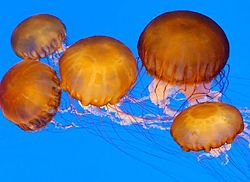 Sea nettles, Chrysaora quinquecirrha
| ||||
| Scientific classification | ||||
| ||||
|
Animals are a major group of organisms, classified as the kingdom Animalia or Metazoa. In general they are multicellular, capable of locomotion and responsive to their environment, and feed by consuming other organisms. Their body plan becomes fixed as they develop, usually early on in their development as embryos, although some undergo a process of metamorphosis later on.
The name animal comes from the Latin word animal, of which animalia is the plural, and ultimately from anima, meaning vital breath or soul.
Characteristics
Kingdom Animalia has several characteristics that set it apart from other living things. Animals are eukaryotic and multicellular, which separates them from bacteria and most protists. They are heterotrophic, generally digesting food in an internal chamber, which separates them from plants and algae. They are also distinguished from plants, algae, and fungi by lacking cell walls.
Structure
With a few exceptions, most notably the sponges (Phylum Porifera), animals have bodies differentiated into separate tissues. These include muscles, which are able to contract and control locomotion, and a nervous system, which sends and processes signals. There is also typically an internal digestive chamber, with one or two openings. Animals with this sort of organization are called metazoans, or eumetazoans when the former is used for animals in general.
All animals have eukaryotic cells, surrounded by a characteristic extracellular matrix composed of collagen and elastic glycoproteins. This may be calcified to form structures like shells, bones, and spicules. During development it forms a relatively flexible framework upon which cells can move about and be reorganized, making complex structures possible. In contrast, other multicellular organisms like plants and fungi have cells held in place by cell walls, and so develop by progressive growth. Also, unique to animal cells are the following intercellular junctions: tight junctions, gap junctions, and desmosomes.
Reproduction and development
Nearly all animals undergo some form of sexual reproduction. Adults are diploid or occasionally polyploid. They have a few specialized reproductive cells, which undergo meiosis to produce smaller motile spermatozoa or larger non-motile ova. These fuse to form zygotes, which develop into new individuals.
Many animals are also capable of asexual reproduction. This may take place through parthenogenesis, where fertile eggs are produced without mating, or in some cases through fragmentation.
A zygote initially develops into a hollow sphere, called a blastula, which undergoes rearrangement and differentiation. In sponges, blastula larvae swim to a new location and develop into a new sponge. In most other groups, the blastula undergoes more complicated rearrangement. It first invaginates to form a gastrula with a digestive chamber, and two separate germ layers - an external ectoderm and an internal endoderm. In most cases, a mesoderm also develops between them. These germ layers then differentiate to form tissues and organs.
Animals grow by indirectly using the energy of sunlight. Plants use this energy to turn air into simple sugars using a process known as photosynthesis. These sugars are then used as the building blocks which allow the plant to grow. When animals eat these plants (or eat other animals which have eaten plants), the sugars produced by the plant are used by the animal. They are either used directly to help the animal grow, or broken down, releasing stored solar energy, and giving the animal the energy required for motion. This process is known as glycolysis.
Origin and fossil record
Animals are generally considered to have evolved from flagellate protozoa. Their closest living relatives are the choanoflagellates, collared flagellates that have the same structure as certain sponge cells do. Molecular studies place them in a supergroup called the opisthokonts, which also include the fungi and a few small parasitic protists. The name comes from the posterior location of the flagellum in motile cells, such as most animal sperm, whereas other eukaryotes tend to have anterior flagella.
The first fossils that might represent animals appear towards the end of the Precambrian, around 600 million years ago, and are known as the Vendian biota. These are difficult to relate to later fossils, however. Some may represent precursors of modern phyla, but they may be separate groups, and it is possible they are not really animals at all. Aside from them, most animal phyla with known phyla make a more or less simultaneous appearance during the Cambrian period, about 570 million years ago. It is still disputed whether this event, called the Cambrian explosion, represents a rapid divergence between different groups or a change in conditions that made fossilization possible.
Groups of animals
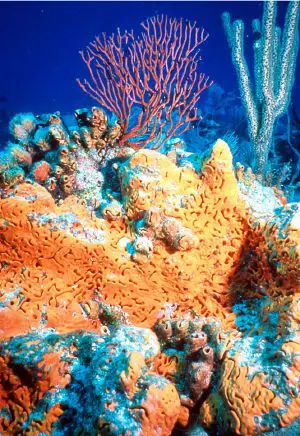
The sponges (Porifera) diverged from other animals early. As mentioned, they lack the complex organization found in most other phyla. Their cells are differentiated, but not organized into distinct tissues. Sponges are sessile and typically feed by drawing in water through pores all Archaeocyatha]], which have fused skeletons, may represent sponges or a separate phylum.
Among the eumetazoan phyla, two are radially symmetric and have digestive chambers with a single opening, which serves as both the mouth and the anus. These are the Cnidaria, which include sea anemones, corals, and jellyfish, and the Ctenophora or comb jellies. Both have distinct tissues, but they are not organized into organs. There are only two main germ layers, the ectoderm and endoderm, with only scattered cells between them. As such, these animals are sometimes called diploblastic. The tiny phylum Placozoa is similar, but individuals do not have a permanent digestive chamber.
The remaining animals form a monophyletic group called the Bilateria. For the most part, they are bilaterally symmetric, and often have a specialized head with feeding and sensory organs. The body is triploblastic, i.e. all three germ layers are well-developed, and tissues form distinct organs. The digestive chamber has two openings, a mouth and an anus, and there is also an internal body cavity called a coelom or pseudocoelom. There are exceptions to each of these characteristics, however - for instance adult echinoderms are radially symmetric, and certain parasitic worms have extremely simplified body structures.
Genetic studies have considerably changed our understanding of the relationships within the Bilateria. Most appear to belong to four major lineages:
- Deuterostomes
- Ecdysozoa
- Platyzoa
- Lophotrochozoa
In addition to these, there are a few small groups of bilaterians with relatively similar structure that appear to have diverged before these major groups. These include the Acoelomorpha, Rhombozoa, and Orthonectida. The Myxozoa, single-celled parasites that were originally considered Protozoa, are now believed to have developed from the Bilateria as well.
Deuterostomes
Deuterostomes differ from the other Bilateria, called protostomes, in several ways. In both cases there is a complete digestive tract. However, in protostomes the initial opening (the archenteron) develops into the mouth, and an anus forms separately. In deuterostomes this is reversed. In most protostomes cells simply fill in the interior of the gastrula to form the mesoderm, called schizocoelous development, but in deuterostomes it forms through invagination of the endoderm, called enterocoelic pouching. Deuterostomes also have a dorsal, rather than a ventral, nerve chord and their embryos undergo different cleavage.
All this suggests the deuterostomes and protostomes are separate, monophyletic lineages. The main phyla of deuterostomes are the Echinodermata and Chordata. The former are radially symmetric and exclusively marine, such as sea stars, sea urchins, and sea cucumbers. The latter are dominated by the vertebrates, animals with backbones. These include fish, amphibians, reptiles, birds, and mammals.
In addition to these, the deuterostomes also include the Hemichordata or acorn worms. Although they are not especially prominent today, the important fossil graptolites may belong to this group. The Chaetognatha or arrow worms may also be deuterostomes, but this is less certain.
Ecdysozoa
The Ecdysozoa are protostomes, named after the common trait of growth by moulting or ecdysis. The largest animal phylum belongs here, the Arthropoda, including insects, spiders, crabs, and their kin. All these organisms have a body divided into repeating segments, typically with paired appendages. Two smaller phyla, the Onychophora and Tardigrada, are close relatives of the arthropods and share these traits.
The ecdysozoans also include the Nematoda or roundworms, the second largest animal phylum. Roundworms are typically microscopic, and occur in nearly every environment where there is water. A number are important parasites. Smaller phyla related to them are the Nematomorpha or horsehair worms, which are visible to the unaided eye, and the Kinorhyncha, Priapulida, and Loricifera, which are all microscopic. These groups have a reduced coelom, called a pseudocoelom.
The remaining two groups of protostomes are sometimes grouped together as the Spiralia, since in both embryos develop with spiral cleavage.

Platyzoa
The Platyzoa include the phylum Platyhelminthes, the flatworms. These were originally considered some of the most primitive Bilateria, but it now appears they developed from more complex ancestors.
A number of parasites are included in this group, such as the flukes and tapeworms. Flatworms lack a coelom, as do their closest relatives, the microscopic Gastrotricha.
The other platyzoan phyla are microscopic and pseudocoelomate. The most prominent are the Rotifera or rotifers, which are common in aqueous environments. They also include the Acanthocephala or spiny-headed worms, the Gnathostomulida, Micrognathozoa, and possibly the Cycliophora. These groups share the presence of complex jaws, from which they are called the Gnathifera.
Lophotrochozoa
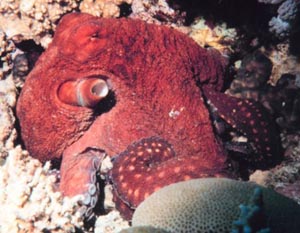
The Lophotrochozoa include two of the most successful animal phyla, the Mollusca and Annelida. The former includes animals such as snails, clams, and squids, and the latter comprises the segmented worms, such as earthworms and leeches. These two groups have long been considered close relatives because of the common presence of trochophore larvae, but the annelids were considered closer to the arthropods, because they are both segmented. Now this is generally considered convergent evolution, owing to many morphological and genetic differences between the two phyla.
The Lophotrochozoa also include the Nemertea or ribbon worms, the Sipuncula, and several phyla that have a fan of cilia around the mouth, called a lophophore. These were traditionally grouped together as the lophophorates, but it now appears they are paraphyletic, some closer to the Nemertea and some to the Mollusca and Annelida. They include the Brachiopoda or lamp shells, which are prominent in the fossil record, the Entoprocta, the Phoronida, and possibly the Bryozoa or moss animals.
History of classification
Aristotle divided the living world between animals and plants, and this was followed by Carolus Linnaeus in the first hierarchical classification. Since then biologists have begun emphasizing evolutionary relationships, and so these groups have been restricted somewhat. For instance, microscopic protozoa were originally considered animals because they move, but are now treated separately.
In Linnaeus' original scheme, the animals were one of three kingdoms, divided into the classes of Vermes, Insecta, Pisces, Amphibia, Aves, and Mammalia. Since then the last four have all been subsumed into a single phylum, the Chordata, whereas the various other forms have been separated out. The above lists represent our current understanding of the group, though there is some variation from source to source.
Usage of the word animal
In everyday usage animal refers to any member of the animal kingdom that is not a human being, and sometimes excludes insects (although including such arthropods as crabs). This confusion stems primarily from the familiarity with zoo animals, farm animals and pets, not from an analytical distinction between insects, humans and the rest of the animal kingdom.
Examples
Some well-known types of animals, listed by their common names:
|
|
|
|
|
Reference
- Klaus Nielsen. Animal Evolution: Interrelationships of the Living Phyla (2nd edition). Oxford Univ. Press, 2001.
- Knut Schmidt-Nielsen. Animal Physiology: Adaptation and Environment. (5th edition). Cambridge Univ. Press, 1997.
External links
- Cane lupo di Saarloos
- Animals Search Engine
- wikianimals.com - Documenting the animal kingdom
- Tree of Life
- A Multimedia Database of Various UK or Endangered Species
- Animals and Birds Names - Large table of words: animal, collective, male, female, young, & home
- English Animal Adjectives
- Sounds of the World's Animals - animal sounds in many languages
- FindSounds - Search the Web for Sounds - sound files including animal sound files
- Australian Animals
- AnimalReviews - animals reviewed and evaluated
- The animal photo archive - Photos of animals
- Photo gallery of animals pictures from the entire world.
- Birds Name Check List in Latin, English, Russian and Hebrew.
- Animals - Wiki Fauna
- Wild Animals Online - an online encyclopedia of wild animals - facts, photos
- The Phyla of the Animals
Credits
New World Encyclopedia writers and editors rewrote and completed the Wikipedia article in accordance with New World Encyclopedia standards. This article abides by terms of the Creative Commons CC-by-sa 3.0 License (CC-by-sa), which may be used and disseminated with proper attribution. Credit is due under the terms of this license that can reference both the New World Encyclopedia contributors and the selfless volunteer contributors of the Wikimedia Foundation. To cite this article click here for a list of acceptable citing formats.The history of earlier contributions by wikipedians is accessible to researchers here:
The history of this article since it was imported to New World Encyclopedia:
Note: Some restrictions may apply to use of individual images which are separately licensed.
